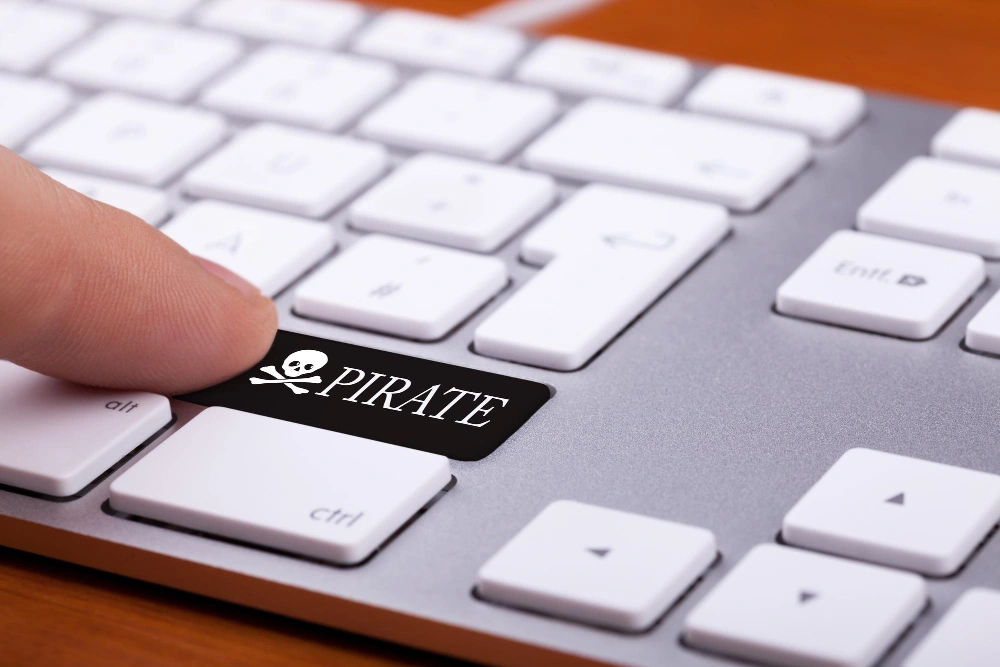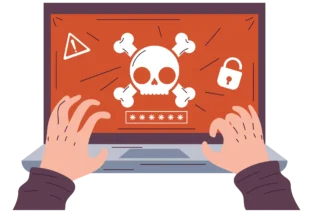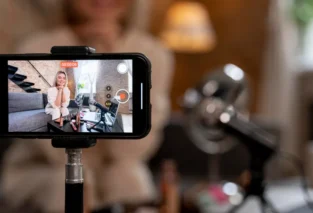
The Shadow Epidemic: Billions of Views Stolen by Easy Piracy Tools, and The One-Click Solution
We live in the golden age of video. Every single day, humanity collectively watches over a billion hours of content on YouTube alone. Platforms like TikTok, Instagram, and countless streaming services have made video the undisputed king of content. For creators, entrepreneurs, educators, and artists, this is a landscape of unprecedented opportunity. Your work can reach millions, build a community, and generate a sustainable income.(Read more How to Protect Your Video Content from Theft: The Ultimate Guide )
But there’s a shadow epidemic running rampant beneath this vibrant ecosystem, a problem that has grown so vast and become so simple to participate in that it threatens the very creators it feeds on. It’s the world of one-click video piracy. We’re not talking about shadowy figures on the dark web using complex software. We’re talking about everyday internet users—students, professionals, and hobbyists—using incredibly simple, free, and easily accessible tools to download any video they want, stripping it of its protections, its context, and its ability to generate revenue for the person who made it.
How big is this problem, really? What is the true cost of a “simple” video download? And most importantly, in a world where piracy is easier than ordering a pizza, can creators do anything to fight back? The answer, it turns out, is a resounding yes. But first, we need to understand the sheer scale of this silent theft. (Read more WordPress Video Security Plugin: Ultimate Protection Against Illegal Downloads)
The Scale of the “Silent Theft”: A Billion-Dollar Black Hole
When we try to quantify the scale of video piracy, the numbers are so large they almost seem fictional. But they are very real, backed by extensive research from cybersecurity firms and industry watchdogs.
Let’s start with a headline figure: pirated video material receives over 230 billion views worldwide each year. To put that in perspective, that’s more than the total number of views on Netflix. It means that a massive, global audience is consuming content through illicit channels, completely invisible to the creators and platforms that produced it.
This isn’t a fringe activity. According to a recent study by CordCutting.com, nearly 50% of American adults admit to having pirated movies or TV shows at some point in their lives. The problem is particularly acute among younger generations, with a staggering 76% of Gen Z and 67% of Millennials admitting to the practice. This isn’t a case of a few bad actors; it’s a widespread, culturally normalized behavior.
The tools that enable this behavior are at the heart of the issue. How many people use them? While it’s impossible to get a perfect count, research from VdoCipher provides a chilling estimate. By analyzing just the top ten most popular video download tools (the kind of websites and browser extensions that come up on the first page of a Google search), they found a combined user base of over 110 million people. Extrapolating from there, they estimate that there are likely 500 million people worldwide who use these piracy tools. That’s potentially one in every four computer users on the planet.
This rampant piracy creates a massive economic black hole. The U.S. Chamber of Commerce’s Global Innovation Policy Center (GIPC) reports that digital video piracy costs the US economy between $29.2 and $71 billion every single year. This isn’t just money lost by big Hollywood studios. It translates directly into lost jobs—somewhere between 230,000 and 560,000 of them annually in the U.S. alone—and billions in lost tax revenue.(Read more Protect Your Videos with VidProtect in 3 Steps!)
The takeaway is clear: this is not a victimless crime or a minor nuisance. It is a multi-billion-dollar shadow industry built on the back of stolen content, enabled by tools that make piracy effortless for hundreds of millions of people.

The “Why” and “How”: The Psychology and Simplicity of Piracy
To solve a problem, you have to understand its roots. Why do so many people, who might otherwise consider themselves law-abiding, turn to video piracy? The reasons are a mix of convenience, cost, and a dangerous misconception that it’s a harmless act.
1. The “Why”: Subscription Fatigue and the Desire for Ownership
In the age of streaming, content is fragmented. A single household might need subscriptions to Netflix, Disney+, Max, Hulu, and a handful of other niche services to watch everything they’re interested in. This leads to “subscription fatigue,” where the cumulative cost feels overwhelming. For many, piracy becomes a way to circumvent this cost.
Furthermore, streaming services offer access, not ownership. You can’t watch your favorite show on a plane without a Wi-Fi connection unless you remembered to download it beforehand (a feature that isn’t always available). Piracy offers a false sense of ownership. Once a video file is on your hard drive, you can watch it whenever, wherever, and forever—or so you think. This desire for offline access and a permanent personal library is a powerful motivator.
Finally, there’s the psychological disconnect. When you click a button on a slick, ad-supported website and a video appears on your desktop, it doesn’t feel like stealing. There’s no broken window or missing wallet. This perceived lack of a direct victim makes it easy for users to justify their actions.
2. The “How”: The Arsenal of Easy Piracy
The technical barrier to piracy has been completely obliterated. The tools used are shockingly simple and fall into a few main categories:
- URL Ripper Websites: These are the most common tools. A user simply copies the URL of a video from a major platform, pastes it into a box on the pirate website, and clicks “Download.” The site’s servers then “rip” the video from the source and provide a direct download link, often in various quality settings.
- Browser Extensions: Perhaps even more insidious, these add-ons integrate directly into the user’s browser. When they are on a video page, a new “Download” button might appear right next to the “Like” and “Share” buttons. It makes piracy a seamless, integrated part of the viewing experience.
- Desktop Software: For those who download in bulk, dedicated software applications offer more features, like downloading entire playlists or channels with a single click, converting video formats, and extracting audio tracks.
What these tools have in common is a focus on user-friendliness. They require zero technical knowledge. The process is often faster and simpler than navigating a legitimate platform’s own download features. This ease of use is the critical factor that has transformed piracy from a niche hobby into a mainstream global phenomenon. It has removed any friction or guilt from the process, making stolen content just another file in a folder.
The Ripple Effect: Why Video Piracy Is More Damaging Than You Think
The casual pirate might think, “I’m just one person downloading one video. Who does it hurt?” The answer is: it hurts everyone, from the independent creator struggling to get by to the pirate themselves. The damage creates a ripple effect that weakens the entire creative industry.(Read more 4 methods to prevent video downloads)
For the Independent Creator:
Imagine you’re an online course instructor. You’ve spent months researching, recording, and editing a comprehensive course that you sell for $100. One person buys it, downloads all the videos using a simple tool, and uploads them to a file-sharing site. Suddenly, your months of hard work are available for free. Every free download is a lost sale, directly taking money out of your pocket.
Now imagine you’re a YouTuber. Your income is based on ad revenue, which is tied to the number of views on your channel. When people download your videos and watch them offline, or re-upload them to other platforms, those views are lost. You get no ad revenue, no credit, and no data on who is watching your content. For creators who rely on brand sponsorships, this is equally devastating. Piracy deflates the view counts and engagement metrics they need to secure deals, making their passion financially unsustainable. It’s a direct attack on their livelihood. (Read more Best Video Host: A Comprehensive Comparison)
For the Creative Ecosystem:
This damage scales up and impacts the entire industry. When production companies and distributors see revenues plummet due to piracy, they become more risk-averse. They have less money to invest in new, original, or experimental projects. They are less likely to take a chance on an unknown writer or director. This leads to a more homogenous and less innovative entertainment landscape. Furthermore, the billions in lost revenue mean fewer jobs. The people affected aren’t just millionaire actors; they’re camera operators, sound engineers, editors, graphic designers, marketers, and countless other professionals who make their living in the creative arts.
For the Pirate:
Here’s the irony: piracy isn’t even safe for the pirates. The websites and tools that offer free downloads are not charities. They make money, often through nefarious means. These sites are frequently loaded with malicious advertising (malvertising), phishing scams designed to steal personal information, and spyware. The downloaded video files themselves can be bundled with viruses, ransomware, or keystroke loggers that can compromise your entire digital life. In the quest to get something for free, users are often paying a hidden price: their own data and security.
The Arms Race: Why Traditional Protection Fails
For years, creators and platforms have tried to fight back, but it has felt like a losing battle. The traditional methods of protection are simply no match for modern piracy tools.
Early attempts involved simple watermarks, but these are easily blurred or cropped out. Copyright warnings are routinely ignored. Even more advanced techniques like domain restriction, where a video is supposed to play only on a specific website, are often easily bypassed. The fundamental problem is that most protection methods operate on a superficial level.
The core challenge is this: for a video to be visible on a screen, the data for that video has to be sent to the user’s device. For a very long time, this meant that if you could see it, you could capture it. Screen recording software is the most basic example of this—it simply records the pixels on the screen, bypassing any underlying protection. The more sophisticated download tools do something similar, intercepting the video data stream as it’s being delivered to the browser and reassembling it into a file.
This has created an arms race where pirates have consistently had the upper hand. For every new protection measure developed, hackers and piracy tool developers have found a workaround within weeks or months. It has left creators feeling powerless, forced to accept that a certain percentage of their work will inevitably be stolen. It seemed like there was no way to truly secure a video once it was released onto the open internet. That is, until now.
The Ultimate Solution: A New Era of Protection with VidProtect
The fight against video piracy required a fundamental shift in thinking. Instead of trying to patch holes, the solution needed to be a fortress built from the ground up. That fortress is VidProtect.site.
VidProtect is not just another layer of protection; it’s a complete, secure video and podcast hosting platform designed for the sole purpose of defeating modern piracy. It operates on a simple but incredibly powerful principle: your content should only be viewable by the people you want, on the platforms you choose, and in a way that makes it impossible to steal.
Here’s how VidProtect changes the game and provides the ultimate solution for content creators:
1. Advanced Encryption and DRM:
This is the core of VidProtect’s power. When you upload a video, it isn’t just stored—it’s secured with AES 256 encryption and Digital Rights Management (DRM) technology. This is the same level of security used by major streaming giants like Netflix and Hulu. It means the video file itself is locked. Even if a hacker managed to intercept the data stream, they would just have a useless, encrypted file. This single feature renders the vast majority of video rippers and download tools completely obsolete. They can’t download what they can’t decrypt.
2. Complete Control with Domain Whitelisting:
VidProtect gives the power back to you. Using a simple dashboard, you specify the exact website domains that are authorized to embed and play your video. If your website is myawesomcourse.com, you whitelist it. Now, if someone copies your embed code and tries to post it on a pirate forum or their own blog, it simply won’t work. The video player will show an error or remain blank. This stops unauthorized sharing and embedding dead in its tracks.
3. AI-Powered Attacker Detection:
VidProtect doesn’t just sit back and wait for an attack. It uses an intelligent, AI-powered system to actively monitor for suspicious behavior. It can detect and block users who are trying to access your content through VPNs known for illicit activity, or identify patterns consistent with attempts to use screen-capturing software. It’s a proactive security guard for your content, working 24/7.
4. Simplicity for the Creator:
All this advanced technology would be useless if it were difficult to use. VidProtect was built for creators, not IT experts. The process is as simple as uploading your video to the platform and then copying the secure embed code to your website. For those using WordPress, there’s a dedicated plugin that makes the integration seamless. You get world-class security without needing to write a single line of code.
5. Comprehensive Analytics:
Because your content is hosted in a secure environment, you get access to rich, reliable analytics. You can see exactly who is watching your content, for how long, and from where, without worrying that a huge chunk of your audience is invisible due to piracy.
In essence, VidProtect.site creates a secure, end-to-end ecosystem for your content. It closes the loopholes that pirates have exploited for years, making your videos truly safe to publish online.

Conclusion: Reclaiming Your Content and Your Livelihood
The scale of video piracy is daunting. Hundreds of billions of views are stolen every year by hundreds of millions of users armed with devastatingly simple tools. The economic and creative damage is immense, undermining the livelihoods of creators and stifling innovation across the board. For too long, this problem has seemed insurmountable, an unavoidable cost of doing business online.
But the narrative is changing. Creators no longer have to be passive victims. The answer is not to give up but to tool up with a solution that is more sophisticated than the threat.
With a platform like VidProtect.site, the power dynamic shifts. Encryption and DRM technology make casual piracy impossible. Domain whitelisting ensures you are in complete control of where your content appears. AI-powered security actively defends against determined attackers. It’s a comprehensive solution that addresses the problem at its very core.
If you are a content creator, an educator, a marketer, or anyone who invests their time, talent, and resources into producing valuable video content, protecting that content is not a luxury—it is essential. It is how you safeguard your revenue, your brand, and your motivation to keep creating. The era of easy video piracy is over for those who choose to end it. The ultimate solution is here, and it’s time to reclaim your work.



